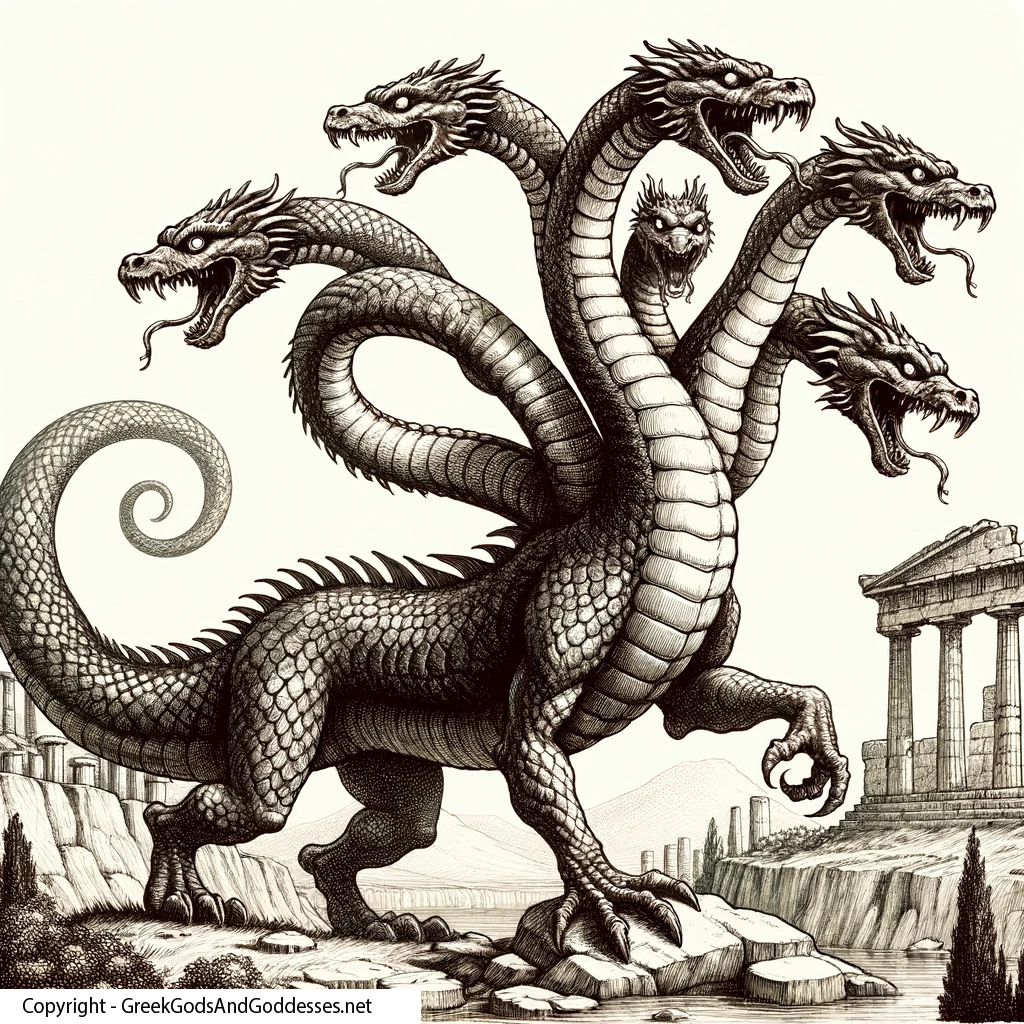In the realm of Greek mythology, where extraordinary heroes confront even more extraordinary beasts, the Lernaean Hydra, or Hydra of Lerna, stands out as one of the most formidable adversaries.
More commonly referred to simply as the Hydra, this serpentine water monster is not just another creature of myth, but a symbol of resilience, regeneration, and challenges that seem insurmountable.

Origins and Characteristics
The Hydra is traditionally depicted as a gargantuan serpent with numerous heads. According to most myths, the monster was born to the ancient sea gods, Echidna and Typhon, both of whom bore several other monstrous progenies, including the Chimera and Cerberus.
One of the Hydra’s most distinctive and daunting traits was its remarkable regenerative ability. When one of its heads was severed, two more would sprout in its place. This characteristic made it nearly invincible to those who attempted to conquer it. Additionally, the creature’s breath and blood were deadly poisonous, making any encounter with it potentially lethal.
The Heroic Encounter: Heracles and the Hydra
The Hydra’s most famed narrative involvement comes from its battle with the Greek hero, Heracles (or Hercules in Roman mythology), which was one of his Twelve Labours assigned by King Eurystheus. Heracles was ordered to slay the Hydra, a task that appeared straightforward until he realized the creature’s regenerative capability.
Situated in the swamps near Lerna, the Hydra had been terrorizing the local inhabitants with its lethal venom and unparalleled strength. Heracles, always ready for a challenge, set forth to Lerna, intent on ridding the world of this menace.
The confrontation was far from straightforward.
For every head that Heracles decapitated, two grew back. Realizing the futility of his efforts, Heracles sought assistance from his nephew, Iolaus. Together, they devised a strategy. As Heracles lopped off each head, Iolaus used a torch to cauterize the wound, preventing the growth of additional heads. This tactic effectively neutralized the Hydra’s formidable defense mechanism.
In addition, Hera, who bore a grudge against Heracles, sent a giant crab to distract and attack him during the battle, further complicating the task.
However, with his characteristic resilience and aided by his nephew, Iolaus, Heracles formulated a strategy. While he removed each head, Iolaus cauterized the open wounds, thereby preventing the emergence of new heads. Eventually, with this tactic, Heracles defeated the Hydra. To ensure the beast’s primary immortal head was neutralized, he buried it under a massive rock.
In a final act of resourcefulness, after defeating the creature, Heracles dipped his arrows in the Hydra’s poisonous blood, turning them into lethal weapons.
Thus, the second labour not only underscored Heracles’ physical strength but also his ability to strategize and adapt in the face of overwhelming odds. The tale serves as a testament to human ingenuity and determination, qualities epitomized by the legendary hero.
Symbolism and Legacy
The Hydra, with its ever-regenerating heads, has been interpreted by scholars and enthusiasts in various ways. Many see it as a symbol of challenges that multiply or persist when confronted directly. Some believe it represents the idea of endurance and resilience, as the Hydra continually rejuvenates despite facing adversity.
In modern culture, the Hydra has made its way into literature, film, and other media as a representation of multifaceted challenges or entities that grow stronger when attacked. Phrases like “hydra-headed problem” have come to symbolize issues that sprout new challenges as soon as one aspect is addressed.
The Hydra, with its roots deep in Greek mythology, remains a symbol of the timeless struggle between man and seemingly insurmountable challenges. Its story, particularly the battle with Heracles, illustrates the virtues of persistence, strategy, and collaboration in the face of daunting adversity. Whether as a mythological beast or a metaphor for life’s complex challenges, the Hydra’s legacy is enduring and influential.
Link/cite this page
If you use any of the content on this page in your own work, please use the code below to cite this page as the source of the content.
Link will appear as Hydra – The Lernean Hydra: https://greekgodsandgoddesses.net - Greek Gods & Goddesses, October 27, 2023